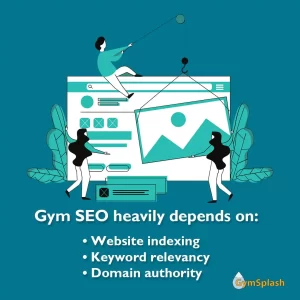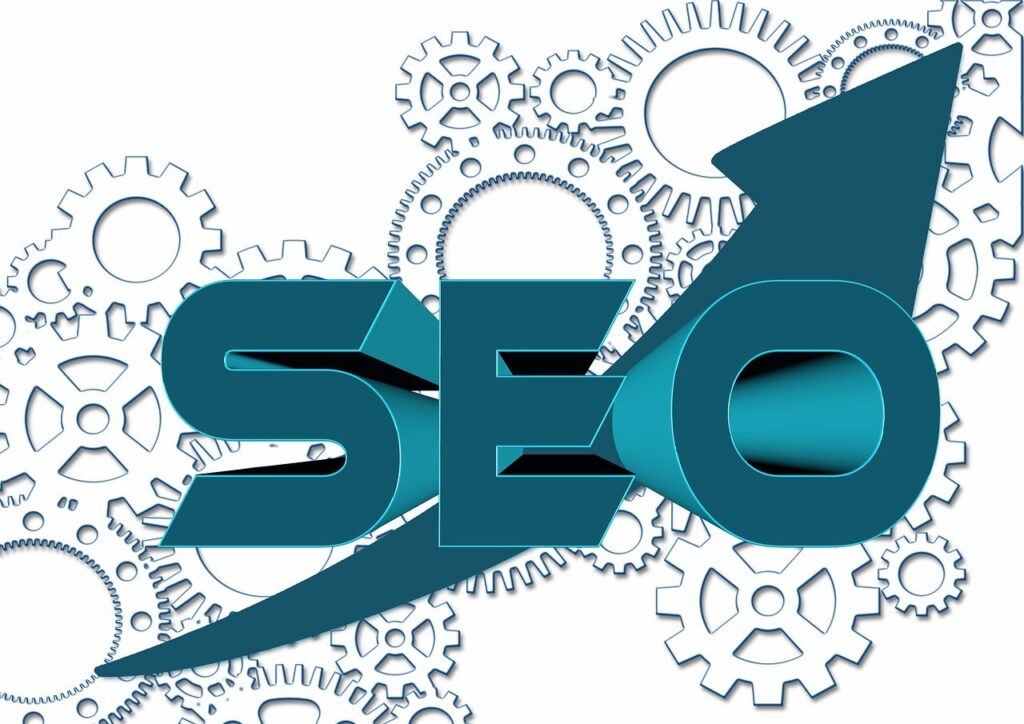When it comes to growing and marketing a gym, search engine optimization (SEO) is a large-scale initiative that absolutely should be used for the best long-term results. That said, SEO for gyms is not much different, by definition, from search engine optimization for other industries. However, understanding how your facility relates to the digital world around it, in relation to your target audience’s queries, becomes more relevant for best application practices.
But before we get too in the weeds on optimizing your online positioning, we will discuss what exactly SEO for gyms and fitness facilities is, how it can help your business from a sales and marketing perspective, what goes into search engine optimization for fitness facilities, where to begin, tools for next steps and analysis, and finally the difference between local and regular gym SEO.
Quick Gym SEO Page Navigation:
SEO for Gyms – What is it?
Let’s start with the most common questions we tend to find people asking: “What is SEO for gyms?” or even “How do I do SEO for a gym?” To answer the first question, the goal of SEO for gyms is really no different than the search engine optimization expectations for any website: getting your website to the top of the search engine results page (SERP) based on a user’s related query. Therefore, SEO involves the steps, methods, practices, and strategies taken to achieve the desired goal of optimizing your fitness business’s website for the best search result placement based on targeted keywords and phrases.
One big misconception that many people have when first getting introduced to search engine optimization with their gym is that they think SEO is something you add to your website. Whether it be a WordPress plugin or specific content writing style/formula where they are told they need to say a specific word or phrase a certain number of times for it to rank better, search engine optimization is actually much different than most believe it to be (or are told it is). What SEO really boils down to is a competition, but more specifically, a popularity competition based on a multitude of ever-changing algorithmic factors.
But going back to the initial question of what SEO for gyms actually is, the most digestible way to describe it is as a general concept first, and then break it down more specifically later. Therefore, SEO for gyms (or any business/website for that matter) becomes the ability to manipulate well-tested ranking factors used by popular search engines to best position your website in the search results page for targeted keywords or long-tail phrases. That’s what SEO is, in a nutshell. We will go into more specifics later, but that’s the general principle we’re working off here.
How SEO for Gyms Can Help Marketing and Sales
One of the key components of marketing is understanding your audience. That said, we don’t want to dive into the nitty-gritty, nerdy details of SEO for gyms before first displaying the actual benefits this can unlock for your fitness facility or training studio.
To begin, let’s review the goal of search engine optimization: to get your website to the top of the SERP results for specific keywords and phrases. That said, understanding how your fitness-based business plays in the buyer’s journey of your target audience is essential for success in marketing your gym and increasing overall sales. Once you know the value proposition, selling points, and common objections associated with your business and target audience, you must research, strategize, and identify the keywords or phrases that you think will give you the best chances of long-term success.
 When developing keywords for your gym’s SEO program, it’s crucial to understand a few key elements about them. Some of these SEO considerations for gym keywords include:
When developing keywords for your gym’s SEO program, it’s crucial to understand a few key elements about them. Some of these SEO considerations for gym keywords include:
- Buyer intent or stage of the buyer journey: awareness, interest, or conversion
- Overall search volume
- Ranking difficulty
- Competition
When reviewing these SEO keyword points for a gym, it’s helpful to focus on the buyer intent and competition from a sales and marketing perspective. This is because these really help with the positioning side of your business and can heavily influence the overall success rate of a lead clicking on your SERP result and converting once on your website. The other two points (search volume and difficulty) relate to the overall online landscape of results surrounding your keywords. Depending on the word, length of phrase, or specificity (or locality) of your terms, you may find that some are too difficult to achieve at this time, or others may yield too low of a search volume to put effort into capturing.
Once your keyword terms are outlined for your facility, the process of enhancing your SEO for the gym begins. This effort will have a direct impact on your overall website traffic, as there is a known trend of increased click rates and website visit volume that is directly correlated with higher positions in search engine rankings (most notably on the first page). Therefore, focusing on keywords that not only yield high-quality search volumes but also align with your marketing and sales strategy (based on buyer intent) and sales funnel flow is imperative for sales and marketing success.
What Goes Into SEO for Gyms
 Search engine optimization typically relies on three main factors, and SEO for gyms is no different. If you’re new to SEO, here are the key points we’ll cover in this section to help you get up to speed quickly.
Search engine optimization typically relies on three main factors, and SEO for gyms is no different. If you’re new to SEO, here are the key points we’ll cover in this section to help you get up to speed quickly.
Gym SEO rankings are heavily dependent on:
- Website domain standing/indexability
- Keyword relevancy
- Domain authority
Website Domain Standing and Indexability for Your Gym’s SEO
To begin discussing how to build SEO for a gym, you need to first understand if your website has any penalties associated with the domain for each of the major search engines. There are a few ways to do this, which we will outline next. However, it’s worth noting that if your website has existing penalties and is not currently being indexed due to them, it may be extremely difficult to remedy this, both in the short and long term. That said, some quick ways to tell if a site has a penalty are to log in to your Google Search Console or Bing Webmaster Tools account and check the “penalties” section. If no issues, you can move on. If you find that your site has issues associated with it, depending on the severity, it may be wise to talk to a professional web developer to remedy them or consider starting a new website on a different domain (if the issues are really severe).
Once you’ve established that your website is in good standing from a penalty standpoint, the next step is to ensure that your website is crawlable and indexed. The first step is to do a quick query on the search platform of your choice and type “site:YourWebsiteDomain.com”. If any results show up for your site, you know that your website has been indexed at least to some degree. The next step is to load your site map file (typically in .xml format) to your Google Search Console and Bing Webmaster Tools accounts. Once loaded, this will help ensure that both search engines can easily crawl and index your site.
Keyword Relevancy when Enhancing SEO for Gyms
 Keyword relevancy is typically what people discuss when they start talking about search engine optimization or keyword mapping. This is because it is generally the part that people feel they have the most control over. Commonly, these actions can be considered “on-page SEO” for a website and typically consist of a list of checkpoints.
Keyword relevancy is typically what people discuss when they start talking about search engine optimization or keyword mapping. This is because it is generally the part that people feel they have the most control over. Commonly, these actions can be considered “on-page SEO” for a website and typically consist of a list of checkpoints.
On-Page SEO Tactics for Gyms:
- Keywords/phrases used in the header(s)
- Contextual keyword/phrase usage within body text
- URL slug including keyword/phrase
- Content built in a topical pillar and cluster design
- Internal linking with proper anchor text
- Page loading speeds
- Utilizing keywords in image alt text properly
- Mobile-friendly website design
To build relevance for keywords and phrases, you must create content on your website that facilitates search engine crawling bots and indexers to understand your content and recognize the relevant keywords and points. Therefore, building out content pages in a pillar and cluster design around mapped keyword topics is an excellent approach for improving your gym’s website relevance for essential phrases and terms identified in your overall online organic sales and marketing strategy.
Over time, with a lot of quality content and proper planning, you can build out a strong topical authority regarding a range of similar terms and phrases within a specific category. This is an excellent strategy for gyms looking to enhance their highly specialized SEO efforts or operate within a niche portion of the market. Further, your website doesn’t have to focus on one category term solely; you can develop multiple strategies for additional terms, words, and phrases. Unfortunately, the most significant limiting factor becomes the amount of work necessary to build the foundation and keep the content relevant, accurate, interesting, and shared.
Website Domain Authority and Improving Your Gym’s SEO Ranking Results
The final piece of the ranking puzzle, and we would dare to say the most influential aspect from a pure SEO-focused mindset, is website domain and page authority rankings. In the early days of search engine optimization, Google used to publish a metric called “PageRank,” which gave a score of 0-100. Over time, it became a primary measurement point amongst marketers and SEO specialists to calculate keyword ranking difficulty by directly comparing PageRank values of competing pages. This then became the primary target for many to focus on when figuring out how to manipulate PageRank values, thus influencing display positioning on the SERP.
Since then, Google has removed the availability of PageRank metrics. Similar calculations are estimated by many of the well-known SEO solution providers in the market but are referred to as a different term like “Domain Rating” or “DR”. Again, these authority calculations are just estimates based on their assumptions on how Google or other major search engine providers operate – no one but the search engine companies themselves know the actual calculations and ranking factors behind their algorithms. But an estimated domain authority number, for the most part, can still be a great tool when working to improve the web search result rankings by implementing SEO for your gym.
Here is a quick breakdown of how it works. Most leading search engines likely use a variant of domain authority as a significant factor when classifying and ranking sites in web query results. Therefore, having a higher domain authority score should lead to a better ranking position. While most DR estimation sites give you an idea of your website’s total score, other factors come into play when considering results position based on the actual page that would be displayed’s DR value compared to other domains based on keywords or phrases in the query (i.e. “gymsplash.com” may have a different score than “gymsplash.com/learning/marketing” in the eyes of the search engine when looking for results on a search for “How to do marketing for a gym”).
So, how do you increase your DR value for gym SEO improvement? Backlinks! Domain authority grows via collecting quality backlinks from other credible and authoritative websites. When they link to you, they pass a bit of “link juice” to your website, which, in turn, signals an improvement to your authoritative ranking score. Backlinks can come from anywhere and can point to any page on your website domain to pass along value (remember how we mentioned certain pages can contain different score values compared to a search result competitor’s specific page value? This is how that score discrepancy would come about). Another factor involved in keyword ranking and backlinks is the anchor text used in the referring link when linking to you. If the anchor text contains specific keywords or phrases, it will give an additional boost to the ranking algorithm.
Points of Caution When Working on Your SEO
Now that you know what goes into SEO for a gym, there are a few warning points to keep in mind. The first goes back to our mention of penalties on a website. One of these potential penalties is for “over optimization,” which can be flagged for using exact keywords or phrases too frequently in the same piece, unnatural usage, or other prevalent bad practices, such as keyword stuffing.
The second point of warning is around backlinks and authority – many times, when people learn this, they go into research mode to find out how to get more backlinks, and quickly discover that you can purchase backlink packages online from third-party sellers. While we won’t deny that this can be a tempting offer, too often these links turn out to be spammy, a short-lived boost, or even provide negative value (yes, that’s a thing) to your domain. A baseline recommendation is to avoid buying backlinks online and focus on organic growth or backlink outreach through guest posting.
The third point of caution concerns anchor text. Similar to backlinks, when people learn that anchor text can influence keyword ranking, many people want to start getting a lot of very specific, keyword-filled anchor text backlinks to their site. While on the surface, that seems like a great idea, this has been found to be a trigger for an over-optimization penalty if done too frequently.
Where to Begin with Search Engine Optimization for Gyms
If you run a new facility or are a seasoned gym owner, starting with search engine optimization may seem like an overwhelming process. But let’s break it down to simplify the process and get you started on the right foot.
When instituting the process of gym SEO enhancements, start with the end in mind. From a business perspective, that will probably be a sales or revenue-based goal. We say this because you want your SEO strategy to be more than just a marketing function for awareness. You will also want a strong sales and marketing function that supports the gym’s strategic business plan. With that in mind, it’s necessary to consider which keywords and phrases most applicably align with your target audience, buyer’s journey, and business growth goal.
For many owners, keywords related to your niche or specialty will likely be a great starting point. This is because it quickly aligns you with people searching for exactly what you provide. An example would be a gym that has an equipment (and audience) emphasis to powerlifting – in this case, “powerlifting gym” would be the keyword you would want to be ranking for, especially as it relates to local searches (i.e. “powerlifiting gyms near me” or “powerlifting gyms in my area”). You can also do this with other related keywords, especially if you have sub-niche markets or multiple target audiences (or different values within audience groups).
Once your keywords are established, the next step is to build relevance around those specific keywords and phrases within your website domain. To accomplish this, you will need to create content that uses these keywords strategically (see the “On-Page SEO Tactics for Gyms” list above). Furthermore, you will want to help search engines understand which pages for these keywords or phrases are the most important. This can be accomplished with the pillar and cluster page design and interlinking strategies also mentioned in the on-page SEO list. One note worth mentioning is to break up your targeted words or phrases into a keyword mapping strategy where the pillar page is optimized for your most impactful keyword and each cluster page address a separate specific keyword and links back to the pillar page (and possibly to another related cluster page as well if you’d like).
After you’ve published your keyword pillar/cluster pages, the next goal (realistically, you should be working on this all the time in the background anyway) is to increase your domain authority through backlink cultivation. This can be done through sponsorships, partnerships, being referenced as a source, or being included in industry index lists, among other methods. It’s just important to continuously try to improve and strengthen your backlink profile with high-quality and authoritative domain links (bonus points if you can occasionally get a keyword anchor text-based link pointing to the proper page associated with the word/phrase).
Check out our GymSplash List of Free SEO Tools for Gyms Google Sheets Document.
The final step is tracking, monitoring, and continuously improving on your efforts. Unfortunately, SEO for gyms is not just a set-it-and-forget-it project. As search engine algorithms change, certain aspects of SEO strategies may become more (or less) effective. Keeping a continuous eye on your keyword ranking, search result (impressions and clicks) charts, and overall website traffic patterns can help you stay abreast of the overall health of your search engine strategy. Further, you will probably realize that distinct keywords/phrases perform better/worse over time, or that patterns may appear or sudden spikes happen. With the proper tools installed and data available, you can identify reasons or narrow down known variables that may have affected your traffic and SERP results related to your website.
SEO Tools for Gyms to Analyze Progress and Success
When it comes to tracking and analyzing SEO for your gym, having the right tools for the job is imperative. In this section, we will break down the key areas where you need to implement tracking and monitoring tools to collect, analyze, and take appropriate action on your search engine optimization efforts.
Keywords
As we mentioned earlier on this page, starting with your gym’s specific keywords and phrases that make the most sense for your business growth goals and marketing initiatives is vital. Therefore, keyword research should be one of the first steps you take to implement SEO tools to help with.
To start your process, consider using keyword exploration and expansion tools such as similar words or phrases, long-tail keyword generators, “people also ask” features, similar results, phrasing auto-complete, and even AI with specific prompts. These tools can help you get started. Leveraging these methods, you will be able to start generating a comprehensive list of keywords, phrases, questions, and related topics that you can later reference, pull from, or structure in ways that make sense for your content generation within your sales funnel, based on the relation to your sales journey.
After you feel you have a working list of targeted words and phrases to focus on with SEO for your gym, the next step is to research the landscape of traffic volume, competition, and difficulty. There are plenty of tools out there that allow you to upload or manually enter lists and get estimates of monthly traffic volume and perceived ranking difficulty. Please note that these are estimated numbers, and the difficulty rankings can be deceiving depending on your ranking goals and who your competition is. One tool that we can recommend to get you started on researching your keywords like this would be Google Ads “Keyword Planner” tool that can help you estimate search volumes and forecasts (and ‘difficulty’) for keywords as well as discover new keywords within your space (Note: these rankings are estimated based off of ads, so it may or may not directly relate to the ranking difficulty associated with search engine optimization for gyms or keywords you are targeting).
The last point on keywords is analyzing and tracking. Again, there are plenty of options on the market for monitoring your gym website’s SEO rankings, health, score, etc. That said, utilizing site audit tools to ensure you are properly implementing on-page SEO for your gym and tracking how many new terms you rank for, SERP featured results, or lost keywords is critical to understanding if your strategy is working. Additionally, knowing which keywords are your primary drivers of traffic and conversions is monumental to overall success. And with that, ensuring you keep a close eye on them and can monitor their ranking statuses (ideally daily, not just average) will give you even stronger insights into what is working (or not working) with your gym’s SEO strategy.
Website
One of the more common topics discussed with SEO for gyms is how your website looks, reads, loads, and is coded, among other things. That said, you can implement website SEO audit tools to test many of these elements in one go. These can help give you insights as to how well your website loads on different devices (Note: as a best practice, your website probably should be optimized for cell phone usage), test internal/external link validity, check on-page structure hierarchies, give suggestions of enhancements, and even help calculate scores for keyword relevancy based on content.
Too often, people find that their out-of-the-box website builders will bog down their site loading speeds due to code bloat. Audit tools can help identify areas where you can make changes or find unnecessary code that improves the overall performance of your site. Similarly, ensuring that you host your images (especially large background images that aren’t set to lazy load) in the more modern .webp file type can help reduce the overall file size of your images, which in turn helps decrease the website’s page load times.
Traffic
The last topic we will mention here is website traffic. While website traffic itself isn’t typically a pure SEO metric (it’s the byproduct of good SERP positioning, properly aligned content, and appealing copy), analyzing traffic patterns can help give you additional insights into your gym’s SEO quality.
Most website traffic tracking and analysis tools break down your visitors by category (e.g., organic, paid, social). Focusing on the organic topic, you can see how much (or what portion) of your traffic is directly correlated to your SEO efforts. With that in mind, if you start noticing decreases or increases in your overall website traffic, analyzing your traffic patterns from various channels can help you gain insights into where those changes are stemming from.
SEO vs Local SEO for Gyms and Why it Matters
Our last topic to cover is the differences between regular search engine optimization and local SEO for gyms. Before we dive into describing the differences here, we need to first talk about how these two are similar.
On the surface, the objective of both SEO and Local SEO is to get your gym to the top of search results for your specified keywords, attracting people in your target audience. That’s it, that’s the goal of search engine optimization in general. Both of these practices (local and general SEO) still rely on the same fundamental principles for ranking: relevancy, authority, and avoiding penalties on your website. If there are substantial issues in any of these areas, it can seriously impact your SERP ranking score or ability.
Where they begin to differ is more on the local SEO side of things. Due to the nature of geographic proximity, region-specific businesses often receive a natural boost in search results for queries referring to services or goods near the user. Therefore, local gyms, studios, or fitness facilities have an opportunity to naturally rank higher for their target audience within their service area. But similar to on-page SEO best practices and strategies, local SEO has its own set of tactics that can help you move the dial, especially when ranking against other similar local options.
Local SEO for gyms is often heavily influenced by a search engine’s ability to naturally place you in a specific location. Therefore, ensuring that your website displays your address clearly (and accurately – we suggest exactly matching what shows up on your gym’s Google Business Profile) on your home page and/or on a “contact/visit us” page can help improve success. Additionally, making sure you’ve established or claimed your Google Business Profile is essential. Also, fully filling out your profile with accurate information, answering Q&As, getting consistent quality reviews, and loading high-quality photos can help improve the overall power of your page results.
Aside from your address, search engine indexers can also use local references and links to better understand your location. This is an interesting factor, as it can be easily implemented in blogs or directions by calling out well-known landmarks, businesses, or locations within your business’s neighborhood. Furthermore, we mentioned how vital backlinks pointing to your website from other credible websites are in building your own site’s authority. With this in mind, getting links from local businesses is another way to not only boost authority but also help improve a search engine’s chances of accurately placing your business.
Making a Splash
For those embracing the digital landscape and looking to utilize SEO for their gym’s benefit, looking at this initiative as a long-term project is vital. Although you may see peaks and valleys over time, the goal with gym SEO enhancements is to be consistent and in line with your business’s growth goal as well as strategic marketing plan. Leveraging the core principles outlined on this page along with other marketing campaigns and strategies, you can help improve and round out your website traffic diversity, which can ultimately lead to big-picture growth.
SEO Blog Posts

What is Local SEO for Gyms
Getting found on Google is the digital pinnacle of success regarding cultivating leads and growing your business. This effort to

5 Free Tools to Use When Analyzing Your Gym’s Website
We often discuss utilizing marketing ideas to grow a gym in our blog, but one of the key factors in

10 Gym Marketing Ideas to Grow Memberships
Coming up with gym marketing ideas to make your fitness business stand out in a crowded market is the name

Reputation Management for Gym Online Reviews
Gym online reviews are an essential function of their digital presence for fitness business owners working to market their company

How to Get Your Fitness Facility to Rank on Google Locally
The importance of Google in driving leads and awareness for gyms and personal training studios is undeniable. Yet achieving a

Understanding and Utilizing Google My Business for Gym Local SEO
Whether you own a large-scale fitness facility or a boutique personal training studio, establishing or claiming your gym’s Google Business

Leveraging Local SEO to Dominate Your Fitness Studio’s Neighborhood
When fitness-based businesses want to grow, the typical solution of “get found on Google” is presented as the fix. While

3 Simple Things to Start Marketing a Gym Right Now
Whether you are just opening a new fitness studio or you’ve owned a facility for a while, marketing a gym

How to Advertise Your Gym on a Budget in 2024
When it comes to marketing your gym, the idea of running Instagram or Facebook ads might come to mind first.

Local News and Press Releases Can Help Your Fitness Studio
Years ago, press releases, radio ads, news stations, and advertisements in magazines or newspapers were the standard for businesses marketing

3 Tools to Test Your Gym’s Website for SEO
It’s probably fair to assume a common goal for most gym owners is to have their facility show up as

5 Reasons Why Your Gym Needs a Website
If you are running a fitness-based facility in these current times and don’t have a website established for your business,
